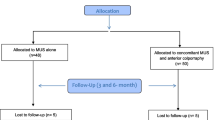Abstract
Our objective was to evaluate the outcome of laparoscopic Burch colposuspension in women with recurrent stress urinary incontinence after failed primary sub-urethral tape procedures. A total of 16 patients were identified, and their data from symptom-specific questionnaires, urodynamic studies and urogynaecological assessment were collected. At a median follow-up of 24.5 months, objective and subjective cure rates were 54.5% and 92.9%, respectively. Average satisfaction score regarding outcome after surgery was 9.3 on a rating scale from 0 to 10. All but one patient had symptoms of urge incontinence pre-operatively with 64.3% experiencing cure or improvement post-operatively. Voiding difficulties were observed in one patient, and post-operative urodynamics revealed a significant decrease in urinary flow rate (p < 0.05) but with no difference in urinary residuals or maximum urethral closure pressure. Severe peri-urethral fibrosis was identified in 62.5% of the patients. Laparoscopic Burch colposuspension is an effective and safe surgical option.
Similar content being viewed by others
References
Nilsson CG, Falconer C, Rezapour M (2004) Seven-year follow-up of the tension-free vaginal tape procedure for treatment of urinary incontinence. Obstet Gynecol 104:1259–1262
Ward KL, Hilton P, UK and Ireland TVT Trial Group (2004) A prospective multicenter randomized trial of tension-free vaginal tape and colposuspension for primary urodynamic stress incontinence: two-year follow-up. Am J Obstet Gynecol 190:324–331
Cardozo L, Hextall A, Bailey J et al (1999) Colposuspension after previous failed incontinence surgery: a prospective observational study. Br J Obstet Gynaecol 106:340–344
Amaye-Obu FA, Drutz HP (1999) Surgical management of recurrent stress urinary incontinence: a 12-year experience. Am J Obstet Gynecol 181:1296–1307
Thakar R, Stanton S, Prodigalidad L et al (2002) Secondary colposuspension: results of a prospective study from a tertiary referral centre. BJOG 109:1115–1120
Maher C, Dwyer P, Carey M et al (1999) The Burch colposuspension for recurrent urinary stress incontinence following retropubic continence surgery. Br J Obstet Gynaecol 106:719–724
Alcalay M, Monga A, Stanton SL (1995) Burch colposuspension: a 10–20 year follow up. Br J Obstet Gynaecol 102:740–745
Jarvis GJ (1994) Surgery for genuine stress incontinence. Br J Obstet Gynaecol 101:371–374
Kjolhede P, Ryden G (1997) Clinical and urodynamic characteristics of women with recurrent urinary incontinence after Burch colposuspension. Acta Obstet Gynecol Scand 76:461–467
Dean N, Ellis G, Wilson P et al (2006) Laparoscopic colposuspension for urinary incontinence in women. Cochrane Database Syst Rev 3:CD002239
Maher C, Qatawneh A, Baessler K et al (2004) Laparoscopic colposuspension or tension-free vaginal tape for recurrent stress urinary incontinence and/or intrinsic sphincter deficiency—a randomised controlled trial. Neurourol Urodyn 23:433–434
Moore RD, Speights SE, Miklos JR (2001) Laparoscopic Burch colposuspension for recurrent stress urinary incontinence. J Am Assoc Gynecol Laparosc 8:389–392
Baessler K, O’Neill S, Maher C et al (2004) A validated female pelvic floor questionnaire for clinicians and researchers. Neurourol Urodyn 23:398–399
Bump RC, Mattiasson A, Bo K et al (1996) The standardization of terminology of female pelvic organ prolapse and pelvic floor dysfunction. Am J Obstet Gynecol 175:10–17
Valpas A, Nilsson CG (2004) Tension-free vaginal tape procedure and laparoscopic colposuspension in the treatment of stress urinary incontinence. Curr Opin Obstet Gynecol 16:319–323
Rezapour M, Ulmsten U (2001) Tension-free vaginal tape (TVT) in women with recurrent stress urinary incontinence—a long-term follow up. Int Urogynecol J 12(Suppl 2):S9–S11
Riachi L, Kohli N, Miklos J (2002) Repeat tension-free transvaginal tape (TVT) sling for the treatment of recurrent stress urinary incontinence. Int Urogynecol J 13:133–135, discussion 135
Moore RD, Gamble K, Miklos JR (2007) Tension-free vaginal tape sling for recurrent stress incontinence after transobturator tape sling failure. Int Urogynecol J 18:309–313
Flynn BJ, Yap WT (2002) Pubovaginal sling using allograft fascia lata versus autograft fascia for all types of stress urinary incontinence: 2-year minimum followup. J Urol 167:608–612
Monga AK, Robinson D, Stanton SL (1995) Periurethral collagen injections for genuine stress incontinence: a 2-year follow-up. Br J Urol 76:156–160
Khullar V, Cardozo LD, Abbott D et al (1997) GAX collagen in the treatment of urinary incontinence in elderly women: a two year follow up. Br J Obstet Gynaecol 104:96–99
Sand PK, Bowen LW, Panganiban R et al (1987) The low pressure urethra as a factor in failed retropubic urethropexy. Obstet Gynecol 69:399–402
Koonings PP, Bergman A, Ballard CA (1990) Low urethral pressure and stress urinary incontinence in women: risk factor for failed retropubic surgical procedure. Urology 36:245–248
Bidmead J, Cardozo L, McLellan A et al (2001) A comparison of the objective and subjective outcomes of colposuspension for stress incontinence in women. Br J Obstet Gynaecol 108:408–413
Stanton SL (1985) Stress incontinence: why and how operations work. Clin Obstet Gynaecol 12:369–377
Bombieri L, Freeman RM, Perkins EP et al (2002) Why do women have voiding dysfunction and de novo detrusor instability after colposuspension? Br J Obstet Gynaecol 109:402–412
Conflicts of interest
None.
Author information
Authors and Affiliations
Corresponding author
Rights and permissions
About this article
Cite this article
De Cuyper, E.M., Ismail, R. & Maher, C.F. Laparoscopic Burch colposuspension after failed sub-urethral tape procedures: a retrospective audit. Int Urogynecol J 19, 681–685 (2008). https://doi.org/10.1007/s00192-007-0506-6
Received:
Accepted:
Published:
Issue Date:
DOI: https://doi.org/10.1007/s00192-007-0506-6




